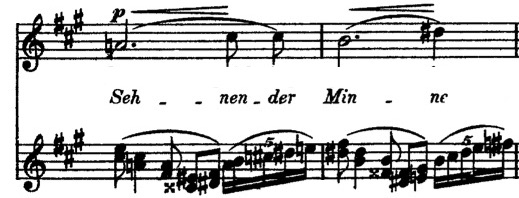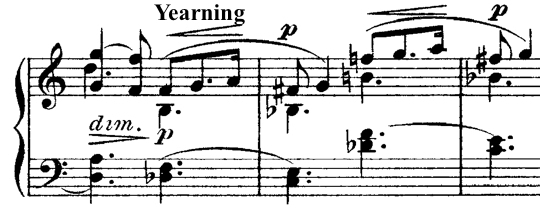Listening Assignment 4
Late Romanticism
Notes on the Romanticism Unit Exam
For the Listening/Score Excerpts portion of the Romanticism Unit Exam, you will see score excerpts from the Listening List below. Any examples below are fair game. Recordings are from NRAWM unless otherwise indicated. For each excerpt you will identify the following:
-
Composer, title, & section
-
Genre—music drama? opera? operetta? orchestral Lied? symphonic poem? symphony?
- Two style features (present in the excerpt) that are typical of the composer
- Style features describe how a specific composer uses elements of music (melody,
harmony, rhythm, texture, color, instrumentation, form, etc.)—simply saying “rhythm” or “texture” is not an answer!
- Answer Study Questions adapted from Listening Assignment 4 Study Questions below
Study Questions
The best way to do well on quizzes, exams, and other assignments in this course is to know the assigned listening well. Listen to each work below as often as you can, study the scores, and learn what the NAWM notes say about each one. For each work you want to be able to answer the following Study Questions:
- What is the genre?
- What is its form?
- What features are typical of Romantic style? Which are not?
- How does the composer use the elements of music? What features of the work are typical of the style? What features are not?
- To answer this, look at the ways the composer uses melody, harmony, rhythm, dynamics, texture, color (timbre), form, text setting, and so on
- How does the work compare with other works in the listening assignment (especially those in the same genre)?
- What features of the work are unique or unusual?
- For the operas, songs, and program works on the Listening List, what is the story? How does each composer use the music, voice(s), and orchestra to tell the story. Which was most important for each composer: music, voices, or orchestra? Consider specific musical elements where necessary, such as melody, accompaniment, tempo, texture, vocal or instrumental effects, and so on.
- What differences do you notice between Italian, German, French, and Russian operas?
In some cases, additional Study Questions below will draw attention to particularly interesting, unique features of particular works. These Study Questions and recordings together will help you prepare for the Romanticism Exam. They require no written report.
Encounter 4 Listening List
After the bloom of early Romanticism, Romantic styles diverged and moved in many different directions. Before you listen, do the readings above and compile short lists of style features (for your own use, not to hand in)—one for each of these important late Romantic composers: Verdi, Wagner, Musorgsky, Brahms, & Mahler. Challenge yourself to identify these features as you listen to works by these composers. The listening materials below will give you practice recognizing these works, genres, forms, and their style features. As always, you really want to read the NAWM notes and follow the score for every work from NAWM!
A. Verdi & Later Italian Opera
A1) NAWM 154—Giuseppe Verdi, La traviata (Italian opera)
- Act III, Scena and Duet
-
Alternate Recording: Verdi, La traviata DVD—Library RESERVE VIDEO 782.1 T782
A2) Naxos—Verdi Aida album (Montserrat Caballé, Plácido Domingo, Muti & New Philharmonia Orchestra)
- Giuseppe Verdi, Aida (Italian grand opera)
A3) NAWM 155—Giacomo Puccini, Madama Butterfly (Italian opera)
- Act I Excerpt—“Vieni, amor mio!” “E’un presente del Mikado,” “Tutti zitti,” & “Cho-cho-san!”
A4) Naxos—Puccini Madama Butterfly album (Mirella Freni, Karajan & Vienna Philharmonic Orchestra)
- Giacomo Puccini, Madama Butterfly (Italian opera)
- Act II. Un bel dì (aria)—track 18
- Score and translation: Blackboard Assignment Resources module—Encounter Listening—Encounter 4—Puccini Madama Butterfly
Study Questions
on Group A:
- What role does exoticism play in these operas by Verdi and Puccini? Is it just window dressing or is it pervasive in these works?
B. Wagnerian Music Drama
B1) NAWM 153—Richard Wagner, Tristan und Isolde (German music drama)
- NAWM 153a—Prelude to Act I
- Alternate Recording: Wagner, Tristan und Isolde DVD1 (chapter 1)—Library RESERVE VIDEO 782.1 T838
- NAWM 153b—Act I, Scene 5 (excerpt)
- Alternate Recording: Wagner, Tristan und Isolde DVD1 (chapter 7, starting at 1:10:00)—Library RESERVE VIDEO 782.1 T838
B2) Naxos—Richard Wagner - Tristan und Isolde album (Birgit Nilsson, Böhm & Bayreuth Festival Orchestra)
- Richard Wagner, Tristan und Isolde (German music drama)
- Act III. Liebestod (aria)—track 29
-
Score, translation and alternate recording: Blackboard Assignment Resources module—Encounter Listening—Encounter 4—Wagner Tristan und Isolde
- Alternate Recording: Wagner, Tristan und Isolde DVD2 (chapter 12)—Library RESERVE VIDEO 782.1 T838
Sudy Questions on Group B:
- Before you listen to the Tristan und Isolde excerpts, read the NAWM 153 commentary and the Guide to Some Leitmotives from Tristan und Isolde below. To guide your listening, find these leitmotives and circle them in your NAWM score. In what ways do the leitmotives help you understand what’s going on? How does Wagner’s use of leitmotives change the role of the orchestra? What is Hanslick’s opinion of Tristan und Isolde (see his concert review in Hanslick, pp. 214-227)?
- Why does Wagner call this work a music drama instead of an opera?
- Tristan has just died as Isolde begins to sing the Liebestod. Read the words (see Encounter Listening in Blackboard) before you listen. What is the meaning of Isolde’s vision? What do Wagner’s program notes (Weiss & Taruskin, pp. 375-377) tell us about the story and the music?
C. Other Late Romantic Opera Traditions
C1) NAWM 156—Georges Bizet, Carmen (French opéra comique)
- Act I, No. 10: Seguidilla & Duet
C2) NAWM 158—Modest Mussorgsky, Boris Godunov (Russian grand opera)
- Coronation Scene
-
Alternate Recording: Modest Mussorgsky, Boris Godunov DVD1 (chapter 5)—Library RESERVE VIDEO 782.1 B734
C3) NAWM 159—Arthur Sullivan, The Pirates
of Penzance (English operetta)
- When the foeman bares his steel (chorus and ensemble)
Study Questions on Group C:
- How are these examples influenced by Italian opera, Wagner, and/or grand opera?
- Which operas above provide good examples of exoticism? of nationalism? How does nationalism differ from exoticism? How are exoticism and nationalism expressed in the music? For instance, what Russian elements can you hear in Boris Godunov?
- What do Musorgsky’s comments (Weiss & Taruskin, pp. 394-396) add to your understanding of his music?
D. Late Romantic Orchestral Music
D1) NAWM 160—Johannes Brahms, Symphony No. 4 in E minor (symphony)
- mvmt. iv (passacaglia form)
-
Alternate Period-Instrument Recording: Blackboard Assignment Resources module—Encounter Listening—Encounter 4—Brahms Symphony No. 4
D2) NAWM 162—Richard Strauss, Don Quixote, Op. 35 (symphonic poem)
- Themes and Variations 1-2 (theme and variations form)
D3a) NAWM 170 (Vol. 3)—Gustav Mahler, Kindertotenlieder (song cycle)
-
No. 1: Nun will die Sonn’ so hell aufgeh’n (orchestral Lied)
D3b) Naxos—Christian Gerhaher – Mahler album (Christian Gerhaher, Nagano & Montreal Symphony)
- Gustav Mahler, Kindertotenlieder (song cycle)
- No. 5: In diesem Wetter (orchestral Lied)—track 9
- Score and translation: Blackboard Assignment Resources module—Encounter Listening—Encounter 4—Mahler, Kindertotenlieder, No. 5 “In diesem Wetter”
D4) Naxos—Gustav Mahler – Symphony No. 5 album (Abbado & Berlin Philharmonic Orchestra)
- Gustav Mahler, Symphony No. 5 (symphony)
- mvmt. iv: Adagietto—track 4
-
Score: Blackboard Assignment Resources module—Encounter Listening—Encounter 4—Mahler, Symphony No. 5, IV. Adagietto
D5) Naxos—Mahler 8 album (Chailly & Royal Concertgebouw Orchestra)
- Gustav Mahler, Symphony No. 8, Symphony of a Thousand (choral symphony)
- mvmt. ii: Chorus mysticus (from Alles Vergängliche to end)—track 18
- Score and translation: Blackboard Assignment Resources module—Encounter Listening—Encounter 4—Mahler Symphony No. 8
D6) NAWM 165—Piotr Il’yich Tchaikovsky, Symphony No. 6 in B minor, Pathétique (symphony)
- mvmt. iii: Allegro molto vivace (sonata form without development?)
D7) NAWM 178 (Vol. 3)—Jan Sibelius, Symphony No. 4 in A Minor, Op. 63 (symphony)
- mvmt. iii: Il tempo largo (rotational form)
Study Questions on Group D:
- Where does each work fit in the absolute vs. programme music controversy?
- Which works above are representative of Postromanticism? Which are representative of nationalism?
- The Brahms symphony movement uses passacaglia form, an older Baroque variation form! In the Baroque passacaglia, a short theme (4 to 8 bars) repeats continuously, usually in the bass line. Brahms announces his 8-measure theme in the winds and brass right at the beginning (E-F sharp-G-A-A sharp-B-low B-E—one note per measure) and repeats it in each subsequent 8-measure group’sometimes in the bass, sometimes in the melody, and often in an inner voice. (Hum along to find the theme more easily!) In the slow tempo middle section (begins with a long flute solo), the passacaglia theme is still there, though you may have to look for it.
- Is Brahms more traditional or more progressive? What unusual rhythmic techniques does he use? What is Hanslick’s opinion of this music in his concert review (Hanslick, pp. 243-245) of this symphony?
- What do Richard Strauss’s leitmotives tell us about Don Quixote and Sancho Panza in Don Quixote? What unusual orchestral ‘effects’ does Strauss use? Why?
- Mahler fell seriously ill in 1901 and almost died. He composed both Symphony No. 5 and portions of Kindertotenlieder during this period of personal crisis and convalescence. What similarities do you hear between these works? What do you learn about Mahler from listening to these songs from Kindertotenlieder? Why did he choose to write songs on the death of children? What in the music conveys these dark feelings? How do you explain the apotheosis at the end of In diesem Wetter?
- Mahler’s life and music present us with many contradictions, and these Mahler works give us two extremes, moving from the angst of the Lieder to the Eighth Symphony’s ecstatic embrace of humanity à la Beethoven’s Ninth. Which do you find more persuasive: the personal, inward-looking expression of the orchestral Lieder or the Eighth Symphony’s universal vision of redemption?
- Often cited as a prime example of Romantic spectacle, the sprawling second (and final!) movement of Mahler’s Symphony of a Thousand sets to music the final scene of Goethe’s Faust, Part II. Faust rode to hell at the end of Part I (in settings by Berlioz, Gounod, et al.), but in Part II the purity of Marguerite’s love paves the way for Faust’s redemption. Published in 1832, Part II exerted a powerful influence on several generations of Romantic composers. Redemption via a pure woman’s sacrifice was a recurring plot device in Wagner operas as well—check out Elisabeth in Tannhäuser or Brünnhilde in Götterdämmerung. Which Mahler style features stand out in his stirring setting of Goethe’s eloquent Chorus mysticus?
- What is meant by rotational form in Sibelius’s Symphony No. 4? Could this term also be used to describe the form of the march movement above from Tchaikovsky’s Symphony No. 6?
|





